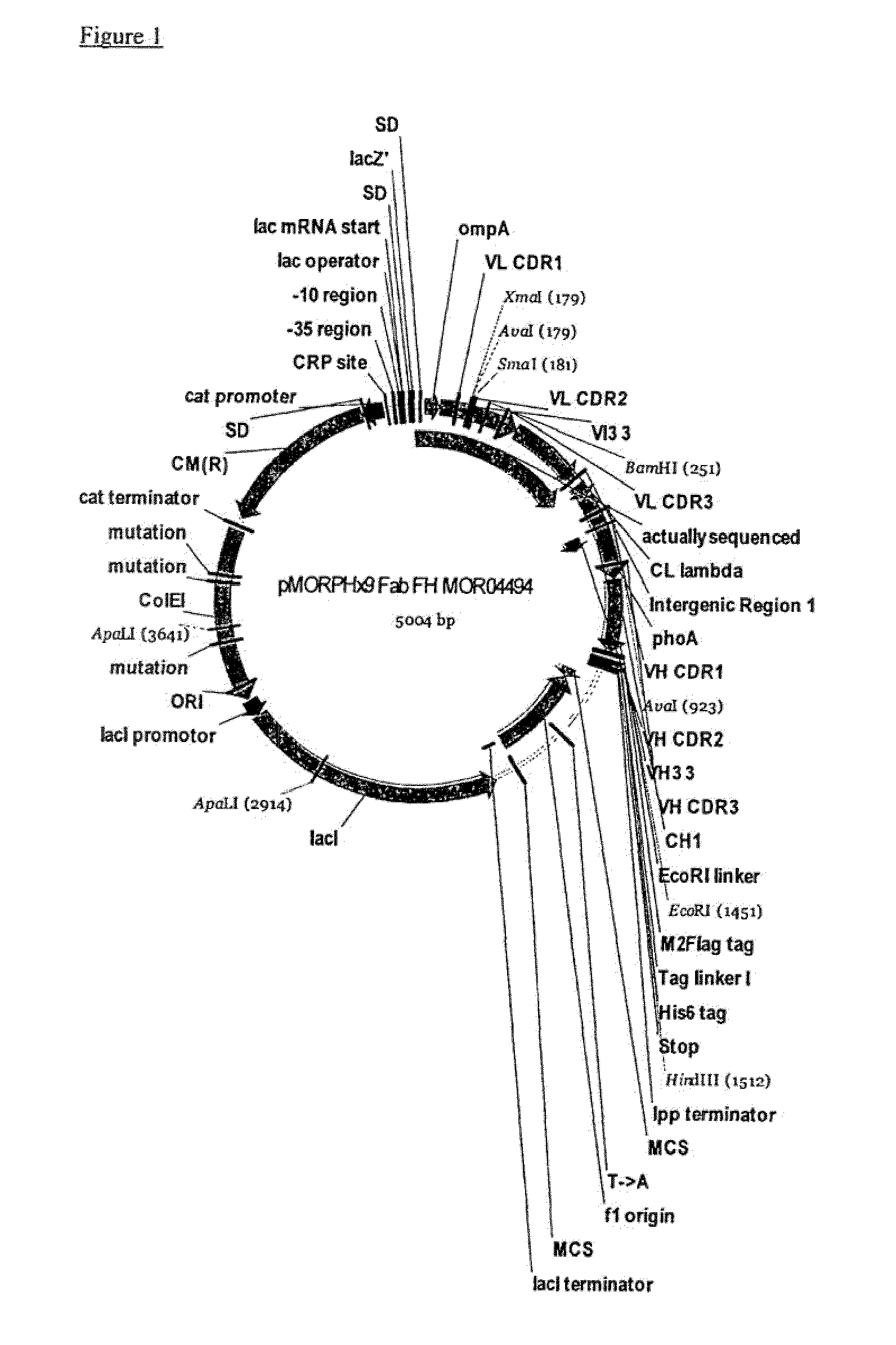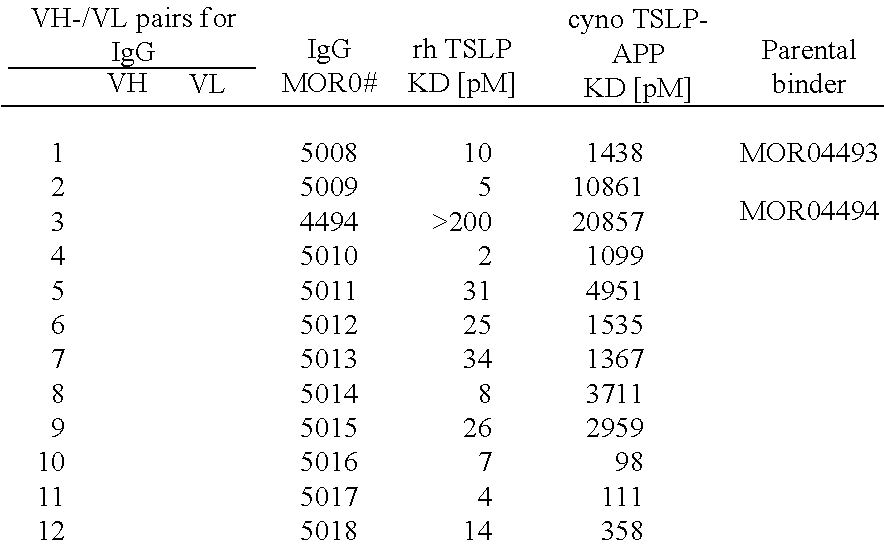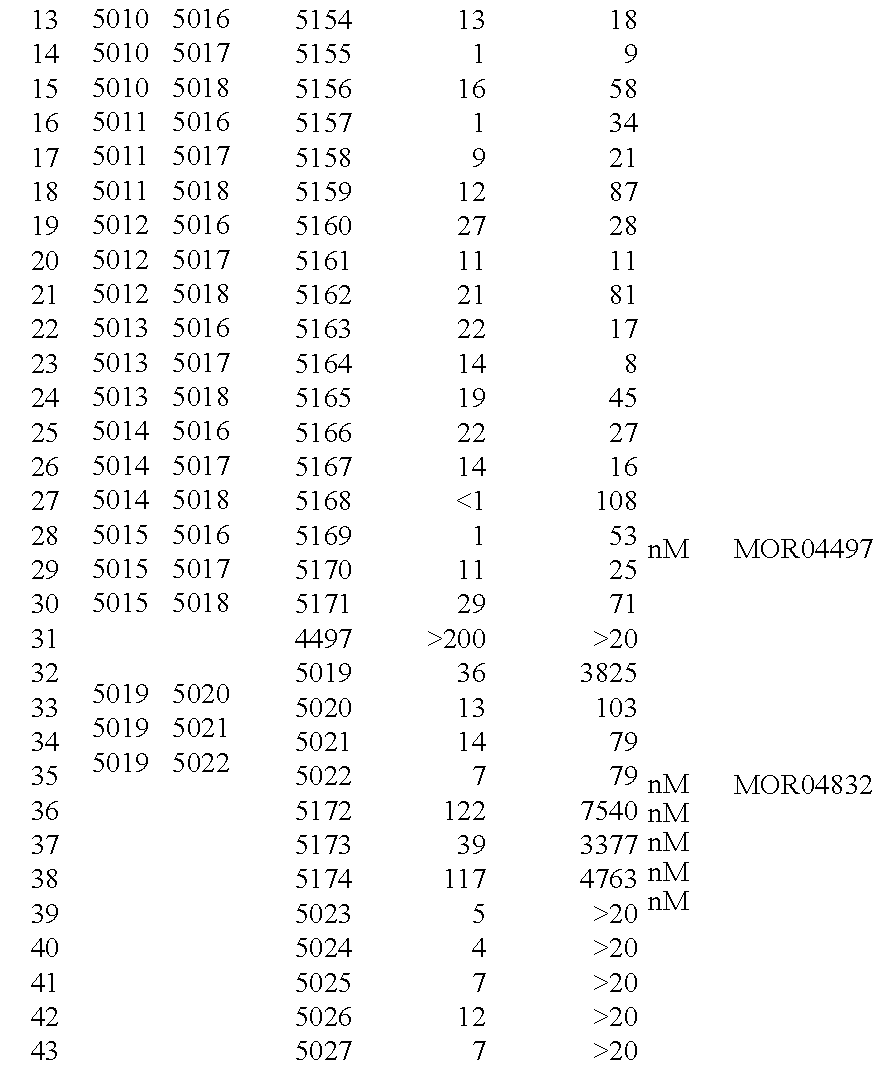Organic compounds
a technology organic compounds, which is applied in the field of human thymic stromal lymphopoietin (htslp) antibodies, can solve the problems of undesired cross-reactivity and limited supply, and achieve the effect of reducing the amount of required dosing or potential side effects
- Summary
- Abstract
- Description
- Claims
- Application Information
AI Technical Summary
Benefits of technology
Problems solved by technology
Method used
Image
Examples
example 1
Generation of Human TSLP-Specific Antibodies from the HuCAL GOLD® Library
[0240]Phagemid Rescue, Phage Amplification, and Purification
[0241]The HuCAL GOLD® library was amplified in 2×YT medium containing 34 μg / ml chloramphenicol and 1% glucose (2×YT-CG). After infection with VCSM13 helper phages at an OD600nm of 0.5 (30 min at 37° C. without shaking; 30 min at 37° C. shaking at 250 rpm), cells were spun down (4120 g; 5 min; 4° C.), resuspended in 2×YT / 34 μg / ml chloramphenicol / 50 μg / ml kanamycin / 0.25 mM IPTG and grown overnight at 22° C. Phages were PEG-precipitated twice from the supernatant, resuspended in PBS / 20% glycerol and stored at −80° C.
[0242]Phage amplification between two panning rounds was conducted as follows: mid-log phase E. coli TG1 cells were infected with eluted phages and plated onto LB-agar supplemented with 1% of glucose and 34 μg / ml of chloramphenicol (LB-CG plates). After overnight incubation at 30° C., the TG1 colonies were scraped off the agar plates and used ...
example 2
Identification of Neutralizing Anti-Human TSLP Fab Candidates that Inhibit TSLP Induced Signaling of the TSLP Receptor
[0260]22 different human TSLP specific antibodies, which were selected from the HuCAL GOLD® library, were tested for the potency to neutralize human TSLP.
[0261]A. Blocking of TSLP Binding to the TSLP Receptor by Anti-Human TSLP Fabs in FACS Assay
[0262]Binding inhibition of biotinylated TSLP to Ba / F3 cells, expressing hTSLPR, hIL7Rα was analyzed by FACS. The Fab antibodies were diluted in FACS buffer (cellwash (B&D) / 3% FCS). 50 μl biotinylated TSLP at 100 ng / ml was incubated with 50 μl of 100 μg / ml Fab for 1 h at RT. To avoid internalization of the TSLP receptor all further steps with cells were carried out at 4° C. or on ice. 100 μl Ba / F3 cells at 2×106 cells / ml were transferred to each well of a 96 well plate (NUNC) and centrifuged at 2000 rpm; 4° C. Cells were washed 2× with 150 μl cold FACS buffer, resuspended with the Fab / biotinylated TSLP mix and incubated for 1...
example 3
Affinity Maturation of Selected Anti-TSLP Fabs by Parallel Exchange of LCDR3 and HCDR2 Cassettes
[0276]B. Generation of Fab Libraries for Affinity Maturation
[0277]In order to increase the affinity and inhibitory activity of the identified anti-TSLP antibodies, 6 Fab clones MOR04493, MOR04494, MOR04496, MOR04497, MOR04609, and MOR04832 were subjected to affinity maturation. For this purpose, CDR regions were optimized by cassette mutagenesis using trinucleotide directed mutagenesis12,13.
[0278]The following paragraph briefly describes the protocol used for cloning of the maturation libraries and Fab optimization. Fab fragments from expression vector pMORPH® X9—Fab_FH were cloned into the phagemid vector pMORPH®25 (U.S. Pat. No. 6,753,136). Two different strategies were applied in parallel to optimize both, the affinity and the efficacy of the parental Fabs.
[0279]Six phage antibody Fab libraries were generated where the LCDR3 of six parental clones was replaced by a repertoire of indivi...
PUM
| Property | Measurement | Unit |
|---|---|---|
| molecular mass | aaaaa | aaaaa |
| molecular weight | aaaaa | aaaaa |
| molecular weight | aaaaa | aaaaa |
Abstract
Description
Claims
Application Information
 Login to View More
Login to View More - R&D Engineer
- R&D Manager
- IP Professional
- Industry Leading Data Capabilities
- Powerful AI technology
- Patent DNA Extraction
Browse by: Latest US Patents, China's latest patents, Technical Efficacy Thesaurus, Application Domain, Technology Topic, Popular Technical Reports.
© 2024 PatSnap. All rights reserved.Legal|Privacy policy|Modern Slavery Act Transparency Statement|Sitemap|About US| Contact US: help@patsnap.com










